Titans of Industry - Kickstarter Preview
 Monday, April 30, 2012 at 11:40AM
Monday, April 30, 2012 at 11:40AM 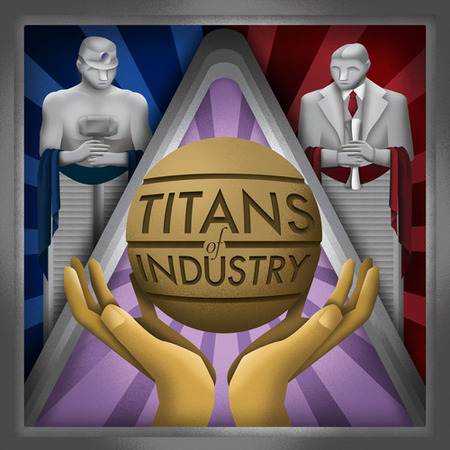
I recently had the opportunity to check out a prototype of a surprisingly fun new game designed by Brian Lewis and published by Gozer Games called Titans of Industry. Titans is a worker placement game set in the industrial sector during the roaring 20's, and is currently seeking funding on Kickstarter. As of this writing, Titans is almost halfway to its funding goal, and has a little more than two weeks to raise the remaining funds.
I really enjoy Titans of Industry, and I feel that it is a game worth Kickstarting. Even in its prototype form, Titans of Industry delivers solid gameplay and sells its art deco theme well; I expect finished artwork and professional 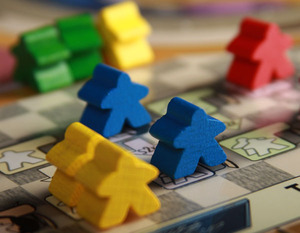 printing will really allow the game to shine. (Due to the fact that the copy of the game I played was in prototype form, I'm presenting this as a preview instead of a full-on review, so keep in mind that the components seen here are handmade and use art that may change.)
printing will really allow the game to shine. (Due to the fact that the copy of the game I played was in prototype form, I'm presenting this as a preview instead of a full-on review, so keep in mind that the components seen here are handmade and use art that may change.)
The Game:
Titans of Industry puts players in the spit-shined shoes of a corporate magnate during a seven year period in the roaring 20's - a time when the production volume of factories was rapidly accelerating due to technological advances in manufacturing, and the skyline of urban America was changing as glittering structures were being erected from steel, glass and concrete, and dared to touch the sky with their art deco spires. Embroiled in the middle of this new prosperity, players in ToI are attempting to grow their companies by accumulating resources and erecting ever taller factories and businesses.
Titans of Industry's core game mechanics revolve around worker placement, and while the worker placement mechanism has become almost ubiquitous in modern games, I'm still surprised at the unique style and interesting play that continues to be produced in the genre. Titans of Industry embraces the spirit of the games that have come before it, without retreading the same ground. While Titans builds on some of the cardinal concepts of worker placement, it hits a sweet spot for me with its combination of resource utilization, building upgrades, and non-confrontational player interactions. In a way, it feels a bit like a cross between Caylus and Seven Wonders, utilizing the worker placement and variable structures of the prior with the empire building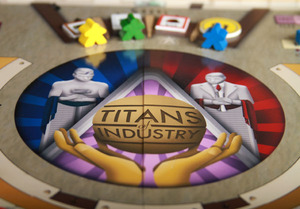 and social feel of the latter; players not only manage their own empire, but find that they must strategically utilize the services and buildings of their competitors in order to succeed.
and social feel of the latter; players not only manage their own empire, but find that they must strategically utilize the services and buildings of their competitors in order to succeed.
Components:
Since the copy of ToI I have is a prototype, I am not going to address the component quality or specific art details individually, but the general art direction of the game, even in it's prototype form, gives the game a unique look and feel. The components are all designed with an art deco flair that really personifies an era. It's a style that is woefully underrepresented in board games, so it's a special treat for me to see it presented so boldly in this game.
Cards: The game utilizes 3 decks of cards throughout gameplay, one deck represents factories that players may purchase and upgrade, the second contains businesses that players may purchase, and the third represents "Corporate Strategy" - special goals that the player can acquire, which will give him bonus points should he reach them.
Workers: Being a worker placement game, the workers are a central part of the game. The prototype copy I have utilizes typical meeples in the 5 vivid player colors. There is also a grey meeple which can be co-opted as a "temp" worker during gameplay.
Tokens: Tokens are used to represent the seven different types of goods that players can collect during the game: Wood, Stone, Brick, Tar, Concrete, Steel, and Glass. Each type of resource token is  color coded, and displays an icon identifying the resource. Money is also represented with tokens instead of flimsy paper bills, which scores bonus points from me.
color coded, and displays an icon identifying the resource. Money is also represented with tokens instead of flimsy paper bills, which scores bonus points from me.
Board: The game board is large, and manages to capture an art-deco feel in the shape and structure of the office that it represents. This makes the board clear and understandable, as well as pleasant to look at.
Gameplay:
Gameplay follows the standard worker placement model, with a few twists. The game takes place over 7 years, with each year equating to a game turn. Each game turn is further split into phases: purchasing buildings, placing workers, resolving workers, and cleanup.
Each turn starts with the opportunity for players to purchase factory and business cards. These cards represent buildings and upgrades that generate goods, money, and victory points for the player. The buildings that the player chooses to buy can have a large impact on how the game plays out. During the course of the game, players will usually find themselves utilizing their opponents' factories and businesses in order to generate and sell resources. This means that purchasing buildings that are in demand can net the player a lot of victory points - however, he needs to be careful not to become too reliant on others in the process.
Next, the players will place their workers. Players may put workers on one of the many spaces on the board which allow them to gain basic resources, bend certain rules, acquire new goals, or gain new workers. Players can also place workers on their own buildings, or their opponents buildings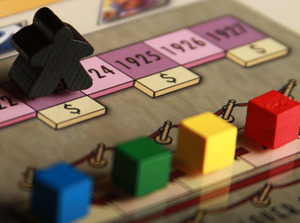 . Utilizing these buildings is the very core of Titans of Industry.
. Utilizing these buildings is the very core of Titans of Industry.
Divided into two types, Factories and Businesses, the buildings drive the producer-consumer economy of the game. Factories generate resources for the player using it, while businesses consume the resources and reward the user with money or victory points. It is to the player's advantage to select the factories and businesses that give him the best payout and align with any special goals he may have. However, he must be careful - when a player places his worker on a business or factory that doesn't belong to him, the owner of the factory automatically receives some victory points. This can make for tough decisions when a player has to decide if the benefit of using the building is worth helping his opponent in the process.
After everyone has placed their workers, the player's actions are resolved. This happens in an order that moves roughly clockwise around the board. During this phase, players receive goods, sell goods, and gain special actions or cards based on the actions that they have taken.
On certain years, players must pay rent on the buildings that they own. This happens after all actions are resolved, during the upkeep phase. Hopefully the player has earned enough money to cover these costs, otherwise he is required to take out high interest loans that must be repaid in order to avoid a stiff victory point penalty.
Play continues this way until the end of the seventh round, when players count up the victory point 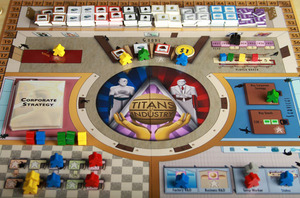 value of all of their buildings, goods, money, as well as any bonus points they have earned from successful corporate strategy goals.
value of all of their buildings, goods, money, as well as any bonus points they have earned from successful corporate strategy goals.
The person with the most victory points is the winner and can revel in his obscene wealth - for the next two years, at least - until the stock market crash of 1929 causes him to lose the shirt off of his back.
Conclusion:
Titans of Industry is a solid game that really deserves to be made. With so many worker placement games out there, it is sometimes hard to look at a games description and immediately see it's potential - but ToI definitely has it.
Surprisingly, Titans turns out to be a very social game; even though the rules expressly forbid direct trading, the fact that players must utilize the other players' buildings to succeed introduces a definite social element. This aspect of the ToI reminds me a lot more of games like 7 Wonders than Caylus. While Caylus has a similar mechanic where players must pay rent to use opponents' buildings, Titans does it in a way that is much more congenial. In fact, the mechanics in the game that govern businesses actually reward players who choose to cooperate, by awarding a bonus when multiple players are on the same building. This design choice transforms the entire nature of the game from a cutthroat competition to a more subtle balancing act. That's not to say there isn't plenty of opportunity  for backstabbing or opportunistic play, it just manifests itself in a way that isn't as obviously antagonistic as many other worker placement games.
for backstabbing or opportunistic play, it just manifests itself in a way that isn't as obviously antagonistic as many other worker placement games.
Players that like to build economic engines will especially enjoy Titans of Industry. The process of purchasing and upgrading buildings, producing resources, and turning those resources into money really speaks to the part of me that loves civilization building games and likes to pump out long card combos in Dominion. It feels odd to say that, because Titans of Industry is very much in the Economic Worker Placement camp and shares very little in common with Dominion or Civ games; yet it somehow manages to scratch that itch for me.
I really appreciate the art style and theme of Titans of Industry as well. Watching it evolve from a spartan prototype with an almost monochromatic color scheme, to the colorful art-deco inspired incarnation that it is today has been exciting. I can only imagine the potential that the game could reach with the proper funding to be professionally printed.
I fear that with only a little over 2 weeks left in its Kickstarter campaign, Titans of Industry may face an uphill battle to secure the rest of the funding it needs. It is a game that really deserves to be played, and I am glad that I was given the opportunity to purchase a prototype copy. If you are sitting on the fence about this one and like worker placement or economic games, I would urge you to head over to Kickstarter and pledge for a copy of your own. I don't think you will be disappointed.
